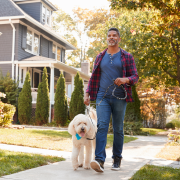When walking your dog becomes an embarrassment: Loving and teaching leash reactive dogs.
Written by Miranda Kurtz, CPDT-KA and Behavior Supervisor at Larimer Humane Society
“GAHHKGAHHKGAHHK” Otter screamed as he pulled, barked, flipped, flailed and sprung towards an approaching Boxer who was off leash with no recall. The Boxer’s owner looked on in horror as her dog beelined for us. Even though Otter was embarrassing me, a CPDT-KA (Certified Professional Dog Trainer-Knowledge Assessed) and Behavior Supervisor, and causing this poor dog owner a moment of panic, I knew that we were okay. I was confident that once the Boxer approached us, Otter would quiet down and the two would bound away in silly, hobble-horsing play bows. How did I know this? Otter had what is called leash reactivity.
Leash reactivity is being reactive on the lead which tends to be displayed with unwanted behaviors, such as pulling, whining, barking, lunging, and in more extreme cases like Otter’s, screaming, cackling, and flailing. Why do dogs display this? For some, it is due to fear and is a clear way to create distance between the stimuli such as people or other dogs and themselves. For others, it is due to the frustration that they can’t interact with whatever they see. For Otter, it was the latter.
Leash reactivity can be both managed and altered through a variety of options. For starters, try managing the behavior using these simple methods: limiting walks to certain hours or being part of the “midnight walking club”, taking walks to the trails rather than a neighborhood, engage in off-leash play rather than leashed walks, and use control harnesses such as an Easy-Walk or Gentle Leader to help keep control. For owners who may need to implement more intervention, here are some tips to better understand and curb your dog’s reactivity. First, you want to determine what the triggers are. On your next walk, take notice of when and why your dog becomes unruly on leash. Once identified, create space between your dog and those triggers, and when your dog displays wanted behaviors again, immediately reward them with a treat or praise. This should help to limit the unwanted responses to triggers and create new ways to cope with those triggers, ultimately creating a new emotional response to such triggers. For example, when your dog sees a squirrel, they may now associate that with getting a treat and walking on. Additionally, you are helping the dog learn new behaviors that will help them cope with the fear or frustration that comes with leash reactivity. A few common and successful techniques are LAT, BAT and CAT.
LAT: Look at that. Rewarding your dog for seeing the trigger as a counter conditioning technique that will create a positive association with that trigger.
BAT: Behavioral Adjustment Training. Rewarding your dog for any minimal reduction, improvement, or absence of aggression. A gradual counter conditioning technique that uses shaping to change the emotional response to a trigger.
CAT 2.0: Constructional Aggression Treatment. Appropriate or healthier behaviors towards a negative trigger are rewarded by allowing distance between the dog and the trigger.
Seeking professional help is highly recommended. We caution the use of any trainers who use shock, choke, or prong collars, aversive methods, alpha training, or balanced training. These methods teach through fear, pain, and intimidation, and are likely to cause increased aggression or such intense fear that they shut down. We recommend trainers who adhere to LIMA (least intrusive, minimally aversive), fear-free, choice-based, and positive reinforcement techniques. Many local trainers offer leash reactive specific courses for dogs that display these behaviors.
In addition, Larimer Humane Society offers a free Behavior Helpline to the community. Give us a call at 970.226.3647 ext. 5130 and one of our Behavior Specialists will happily assist you with your pet’s behavioral needs. You can also visit our website to view a list of FAQ that may answer your question!





